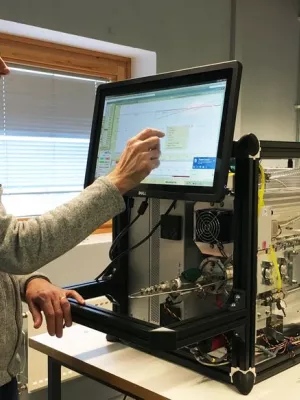
Erik Swietlicki
Professor

Exploring sources of biogenic secondary organic aerosol compounds using chemical analysis and the FLEXPART model
Författare
Summary, in English
Molecular tracers in secondary organic aerosols (SOAs) can provide information on origin of SOA, as well as regional scale processes involved in their formation. In this study 9 carboxylic acids, 11 organosulfates (OSs) and 2 nitrooxy organosulfates (NOSs) were determined in daily aerosol particle filter samples from Vavihill measurement station in southern Sweden during June and July 2012. Several of the observed compounds are photo-oxidation products from biogenic volatile organic compounds (BVOCs). Highest average mass concentrations were observed for carboxylic acids derived from fatty acids and monoterpenes (12. 3 ± 15. 6 and 13. 8 ± 11. 6 ng mg-3, respectively). The FLEXPART model was used to link nine specific surface types to single measured compounds. It was found that the surface category sea and ocean was dominating the air mass exposure (56 %) but contributed to low mass concentration of observed chemical compounds. A principal component (PC) analysis identified four components, where the one with highest explanatory power (49 %) displayed clear impact of coniferous forest on measured mass concentration of a majority of the compounds. The three remaining PCs were more difficult to interpret, although azelaic, suberic, and pimelic acid were closely related to each other but not to any clear surface category. Hence, future studies should aim to deduce the biogenic sources and surface category of these compounds. This study bridges micro-level chemical speciation to air mass surface exposure at the macro level.
Avdelning/ar
- Centrum för miljö- och klimatvetenskap (CEC)
- Kärnfysik
- Institutionen för naturgeografi och ekosystemvetenskap
- MERGE: ModElling the Regional and Global Earth system
Publiceringsår
2017-09-18
Språk
Engelska
Sidor
11025-11040
Publikation/Tidskrift/Serie
Atmospheric Chemistry and Physics
Volym
17
Issue
18
Dokumenttyp
Artikel i tidskrift
Förlag
Copernicus GmbH
Ämne
- Meteorology and Atmospheric Sciences
Status
Published
ISBN/ISSN/Övrigt
- ISSN: 1680-7316